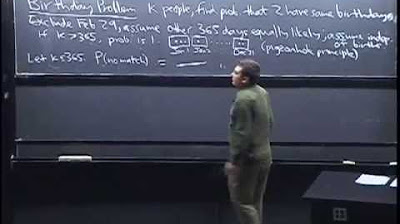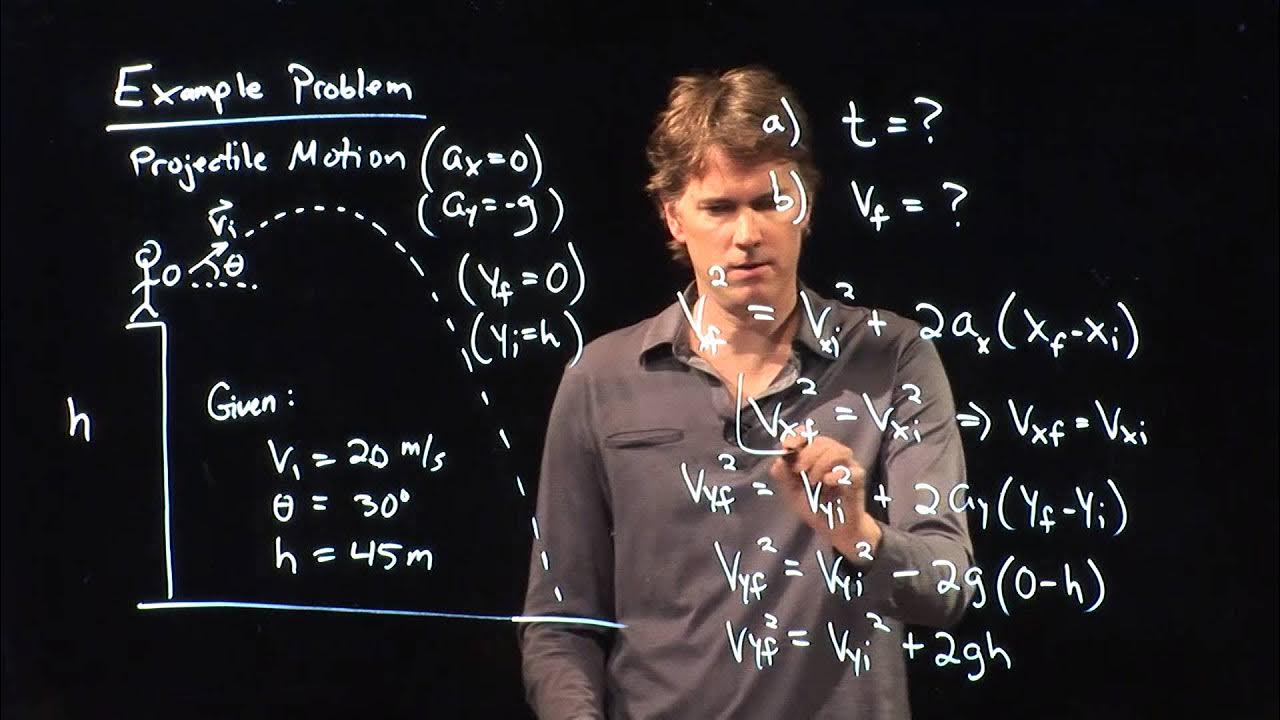Birthday probability problem | Probability and Statistics | Khan Academy
TLDRIn this video, the presenter tackles the classic 'birthday paradox' problem, calculating the probability that at least two out of 30 randomly selected people in a room share the same birthday. Using a creative approach, they invert the problem to find the probability of all 30 having distinct birthdays, which is easier to compute. Through factorials and simplification, they arrive at a surprising result: there's approximately a 70.6% chance of a birthday match in a group of 30, highlighting the counterintuitive nature of the problem.
Takeaways
- 🔢 The problem involves calculating the probability that in a group of 30 randomly selected people, at least two individuals share the same birthday.
- 🎲 Initially, the problem seems complex due to the numerous possible scenarios where people could share birthdays, but the solution simplifies by considering the opposite scenario.
- 📊 The approach taken is to calculate the probability that all 30 people have distinct birthdays and then subtract this from 1 to find the probability of at least one shared birthday.
- 🤔 The script explains that calculating the probability of shared birthdays directly is difficult, but calculating the probability of distinct birthdays is more straightforward.
- 📅 The probability of distinct birthdays for each person is calculated by considering the number of days left after accounting for the birthdays of others in the group.
- 👤 For two people, the probability of distinct birthdays is 364/365, as there are 364 days left for the second person after the first person's birthday.
- 📈 The script uses the concept of factorials to express the probability of distinct birthdays for a larger group, showing the pattern as the number of people increases.
- 🧮 The general formula for the probability of distinct birthdays for 'n' people is \( \frac{365!}{(365-n)! \times 365^n} \), where 'n' is the number of people.
- 📉 As the number of people increases, the probability of all having distinct birthdays decreases, making the probability of shared birthdays higher.
- 📝 The script provides a step-by-step method to calculate the probability for 30 people, emphasizing the use of a calculator and the factorial function.
- 🎯 The final calculated probability that at least two people in a group of 30 share a birthday is approximately 70.6%, which is a surprisingly high figure.
Q & A
What is the main problem discussed in the script?
-The script discusses the probability problem of at least two people in a group of 30 having the same birthday.
Why does the problem seem difficult at first glance?
-The problem seems difficult because there are many possible scenarios where people could share birthdays, and calculating the probability of each scenario individually would be complex.
What is the alternative approach to solving the problem?
-The alternative approach is to calculate the probability that no one shares a birthday and then subtract this from 1 to find the probability that at least two people do share a birthday.
How does the script simplify the calculation of distinct birthdays probability?
-The script simplifies the calculation by using factorials to represent the number of ways to assign distinct birthdays to the group of people.
What is the significance of using factorials in this context?
-Factorials are used to express the product of all positive integers up to a given number, which helps in calculating the number of ways to assign distinct birthdays without repetition.
How many days are considered in the script for calculating the probability of distinct birthdays?
-The script considers 365 days in a year for calculating the probability of distinct birthdays.
What is the formula used to calculate the probability of no one sharing a birthday in a group of 30?
-The formula used is the product of integers from 365 down to (365 - 30 + 1), divided by 365 raised to the power of 30, which is 365! / ((365 - 30)! * 365^30).
What is the calculated probability that no one in a group of 30 shares a birthday?
-The calculated probability is approximately 29.37%, which means there is a 70.63% chance that at least two people share a birthday.
Why is the result of 70.63% significant?
-The result is significant because it shows that in a group of 30 people, it is more likely than not that at least two individuals will share the same birthday.
What is the birthday paradox and how does the script relate to it?
-The birthday paradox is a probability theory that states that in a group of 23 or more people, there is a 50% chance that two people will share a birthday. The script explores this concept with a larger group and calculates the exact probability for 30 people.
Outlines
🤔 Probabilistic Inquiry into Birthday Paradox
The script introduces a classic probability problem involving 30 randomly selected people in a room and the likelihood that at least two of them share the same birthday. The problem is initially presented as complex due to the numerous possible combinations that could result in shared birthdays. The speaker simplifies the problem by considering the complementary probability: the chance that all individuals have unique birthdays, which is easier to calculate. The approach involves understanding the probability space and using it to frame the question in a more manageable way.
📚 Mathematical Exploration of Birthday Probability
This paragraph delves into the mathematical calculation of the probability that all 30 people have distinct birthdays. It starts by establishing the probability for two people having different birthdays, which is 364 out of 365 days. The process is then extended to three people, illustrating the pattern that emerges when calculating the probability for additional individuals. The paragraph introduces the concept of factorials to express the probability in a more compact form, showing how to calculate the probability for 30 people by dividing 365 factorial by (365 - 30) factorial, and then by 365 raised to the power of 30.
🔢 Calculation and Conclusion of Birthday Paradox
The final paragraph concludes the calculation by using a calculator to determine the numerical probability that no one in a group of 30 shares a birthday. The result is approximately 29.37%, which means that there is a 70.63% chance that at least two people in the group share a birthday. This surprising result highlights the counterintuitive nature of the birthday paradox and provides a clear conclusion to the problem presented at the beginning of the script.
Mindmap
Keywords
💡Probability
💡Birthday Paradox
💡Random Selection
💡Combinatorics
💡Factorials
💡Distinct Birthdays
💡Complementary Probability
💡Calculus
💡Pattern Recognition
💡Statistical Significance
💡Counterintuitive
Highlights
Introduction of an interesting probability problem involving 30 people and the likelihood of shared birthdays.
The problem's complexity arises from the numerous scenarios where at least two people could share a birthday.
A simplifying approach to the problem by considering the probability of all people having distinct birthdays instead.
The concept that the probability of at least two people sharing a birthday is equivalent to 1 minus the probability of all having distinct birthdays.
Calculating the probability of distinct birthdays by sequentially reducing the number of available days for each additional person.
General formula for the probability of no shared birthdays among 'n' people using factorials.
The use of factorials to simplify the calculation of the probability for a larger group.
The mathematical pattern in calculating probabilities for different group sizes using factorials.
The final calculation of the probability that no one shares a birthday among 30 people using a calculator.
The surprising result that there is approximately a 70.6% chance that at least two people in a group of 30 share a birthday.
The practical application of the problem in understanding the likelihood of shared birthdays in social groups.
The educational value of the problem in demonstrating the power of probability and combinatorics.
The importance of considering the complementary probability to simplify complex problems.
The demonstration of how to approach probability problems by breaking them down into more manageable parts.
The insight into the birthday problem's paradoxical nature, where common intuition often underestimates the likelihood of shared birthdays.
Transcripts
Browse More Related Video

Lecture 3: Birthday Problem, Properties of Probability | Statistics 110

Projectile Motion Example - How fast when it hits the ground

Probability of making 2 shots in 6 attempts | Probability and Statistics | Khan Academy

The Riddle That Seems Impossible Even If You Know The Answer

Probability with discrete random variable example | Random variables | AP Statistics | Khan Academy

Law of Reflection - Geometric Optics - Physics
5.0 / 5 (0 votes)
Thanks for rating: